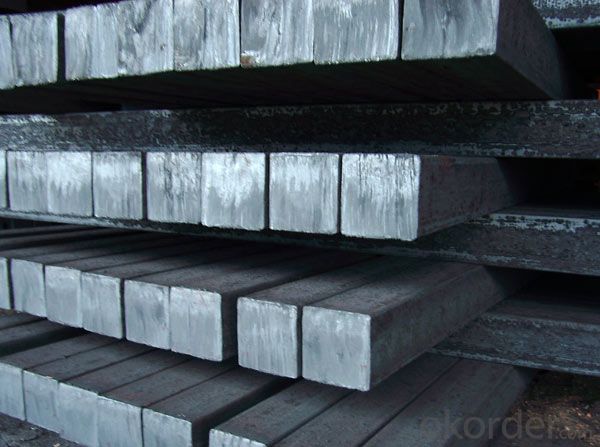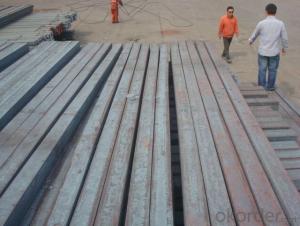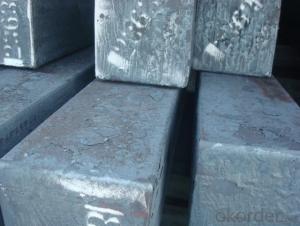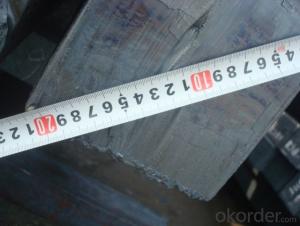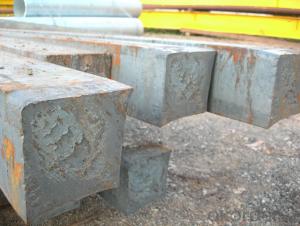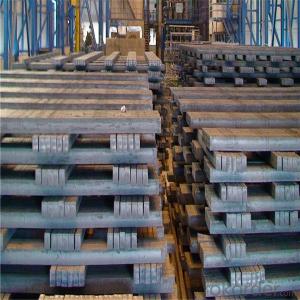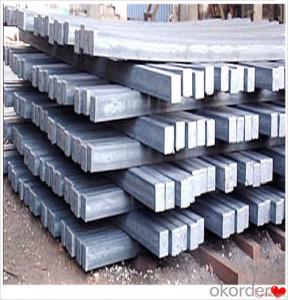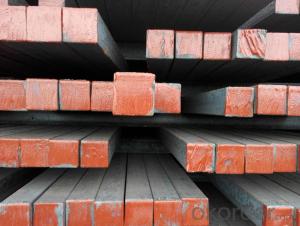Hot Rolled Mild Square Steel Billet Q195, Q235
- Loading Port:
- Shanghai
- Payment Terms:
- TT or LC
- Min Order Qty:
- 25 m.t.
- Supply Capability:
- 200000 m.t./month
OKorder Service Pledge
OKorder Financial Service
You Might Also Like
Product Description:
OKorder is offering Hot Rolled Mild Square Steel Billet Q195, Q235 at great prices with worldwide shipping. Our supplier is a world-class manufacturer of steel, with our products utilized the world over. OKorder annually supplies products to European, North American and Asian markets. We provide quotations within 24 hours of receiving an inquiry and guarantee competitive prices.
Product Applications:
Hot Rolled Mild Square Steel Billet Q195, Q235 are ideal for structural applications and are widely used in the construction of buildings and bridges, and the manufacturing, petrochemical, and transportation industries.
-The Square Steel is normally used as structure steel.
-Row material for other structure steel like steel angles, channels, I-beams, H-beams, etc…
Product Advantages:
OKorder's Hot Rolled Mild Square Steel Billet Q195, Q235 are durable, strong, and resist corrosion.
Main Product Features:
· Premium quality
· Prompt delivery & seaworthy packing (30 days after receiving deposit)
· Corrosion resistance
· Can be recycled and reused
· Mill test certification
· Professional Service
· Competitive pricing
Specifications of Hot Rolled Mild Square Steel Billet Q195, Q235:
-Standard: GB,
-Grade: Q195/Q235 or equivalent.
Chemical Composition:
-Chemical Composition. Q195
Standard | Grade | Element (%) | ||||
GB | Q195 | C | Mn | S | P | Si |
0.06~0.12 | 0.25~0.50 | ≤0.050 | ≤0.045 | ≤0.30 | ||
-Chemical Composition. Q235
Standard | Grade | Element (%) | ||||
GB | Q235B | C | Mn | S | P | Si |
0.12~0.20 | 0.30~0.70 | ≤0.045 | ≤0.045 | ≤0.30 | ||
Measures and Tolerances of Square Steel Bar:
(The section of Square Steel Bar)
-The length of a side and the theoretical weight of Square Steel.
Length of a side(a, mm) | Theoretical weight(kg/m) | Length of a side(a, mm) | Theoretical weight(kg/m) |
6 | 0.283 | 32 | 8.04 |
7 | 0.385 | *33 | 8.55 |
8 | 0.502 | 34 | 9.07 |
9 | 0.636 | *35 | 9.62 |
10 | 0.785 | 36 | 10.17 |
11 | 0.950 | 38 | 11.24 |
12 | 1.13 | 40 | 12.56 |
13 | 1.33 | 42 | 13.85 |
14 | 1.54 | 45 | 15.90 |
15 | 1.77 | 48 | 18.09 |
16 | 2.01 | 50 | 19.63 |
17 | 2.27 | 53 | 22.05 |
18 | 2.54 | *55 | 23.6 |
19 | 2.82 | 56 | 24.61 |
20 | 3.14 | *58 | 26.4 |
21 | 3.46 | 60 | 28.26 |
22 | 3.80 | 63 | 31.16 |
*23 | 4.15 | *65 | 33.17 |
24 | 4.52 | *68 | 36.3 |
25 | 4.91 | 79 | 38.49 |
26 | 5.30 | 75 | 44.16 |
*27 | 5.72 | 80 | 50.24 |
28 | 6.15 | 85 | 56.72 |
*29 | 6.60 | 90 | 63.59 |
30 | 7.06 | 95 | 70.85 |
*31 | 7.54 | 100 | 78.50 |
Notes:
1, The theoretical weights in the list, base on the density of 7.85 g/cm3.
2, The numbers with *mean that they are not regulars or we don’t offer them.
-The allowed tolerance of Square Steel:
Length of a side(mm) | Allowed Tolerance | ||
Group1 | Group2 | Group3 | |
5.5~7 | ±0.20 | ±0.30 | ±0.40 |
7~20 | ±0.25 | ±0.35 | ±0.40 |
20~30 | ±0.30 | ±0.40 | ±0.50 |
30~50 | ±0.40 | ±0.50 | ±0.60 |
60~80 | ±0.60 | ±0.70 | ±0.80 |
80~110 | ±0.90 | ±1.0 | ±1.1 |
110~150 | ±1.2 | ±1.3 | ±1.1 |
150~190 | ―― | ―― | ±2.0 |
190~250 | ―― | ―― | ±2.5 |
Packaging & Delivery of Hot Rolled Mild Square Steel Billet Q195, Q235:
-Packing Detail: The products can be packed in bundles by steel wires.
-Marks:
1, Tag marks: the tag marks will be tied up to each bundle of the products. The information is usually including supplier’s logo and name, product name, made in China, products’ specifications, the painted color and other information requested by customers.
2, Color marks: we will paint both ends of the bundles of these products to make sure that they are more evident. It’s will be more convenient for the customers to distinguish them at the destination port.
-Delivery Detail: 30~45 working days after receive buyer’s T.T. or L/C.
Transportation:
-The products can be delivered by bulk vessel or by container. As for container, products with the length of 6m will be loaded in 20’ container, with 9m or 12m, in 40’ container.
-The maximum quantity of loading of container is 25 tons.
-The products usually are transported to the nearest port from the production place.
Payment:
-Invoicing on theoretical weight or actual weight a s customer’s request.
-FOB, CFR or CIF.
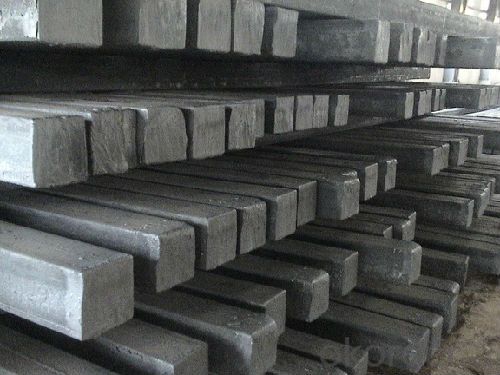
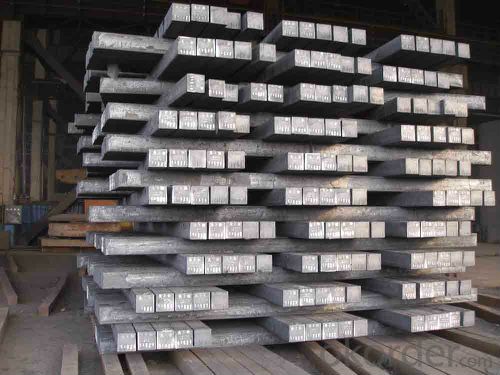
FAQ:
Q1: Why buy Hot Rolled Mild Square Steel Billet Q195, Q235 from OKorder.com?
A1: All products offered byOKorder.com are carefully selected from China's most reliable manufacturing enterprises. Through its ISO certifications, OKorder.com adheres to the highest standards and a commitment to supply chain safety and customer satisfaction.
Q2: How do we guarantee the quality of our products?
A2: We have established an advanced quality management system which conducts strict quality tests at every step, from raw materials to the final product. At the same time, we provide extensive follow-up service assurances as required.
Q3: What is the normal tolerance of Hot Rolled Mild Square Steel Billet Q195, Q235?
A3: Normally 3%-5%, but we can also produce the goods according to the customers' requests.
- Q: What are the specifications for tool steel billets used in the automotive industry?
- The specifications for tool steel billets used in the automotive industry typically include requirements for hardness, toughness, wear resistance, and machinability. These billets are often required to meet specific international standards such as AISI (American Iron and Steel Institute) or DIN (Deutsches Institut für Normung) grades, which define the chemical composition and mechanical properties of the steel. Additionally, the billets may need to undergo specific heat treatment processes to further enhance their performance characteristics.
- Q: How are steel billets used in the manufacturing of kitchen appliances?
- Steel billets are used in the manufacturing of kitchen appliances as the primary raw material. These billets are heated and then shaped or molded into various components such as bodies, frames, handles, or cooktops, which form the structural foundation of kitchen appliances. The high strength and durability of steel make it an ideal choice for withstanding the rigors of everyday use in kitchen appliances, ensuring their longevity and quality.
- Q: How do steel billets contribute to the food processing industry?
- Steel billets are used in the food processing industry to manufacture various equipment and machinery required for food production and processing. These billets serve as the raw material for constructing conveyor belts, mixers, crushers, and other machinery used in food processing plants. Additionally, steel billets are also utilized in the construction of storage tanks, processing vessels, and packaging equipment that maintain hygiene standards and ensure the safe and efficient handling of food products.
- Q: What are the different heat treatment processes for alloy steel billets?
- There are several different heat treatment processes for alloy steel billets, including annealing, normalizing, quenching, and tempering. Annealing involves heating the billets to a high temperature and then slowly cooling them to relieve internal stresses and improve ductility. Normalizing is similar to annealing but involves air cooling instead of slow cooling. Quenching involves rapidly cooling the billets in a liquid medium, such as oil or water, to increase hardness and strength. Tempering is done after quenching and involves reheating the billets to a specific temperature and then cooling them slowly to reduce brittleness and improve toughness.
- Q: Can steel billets be used in the production of kitchenware?
- Kitchenware can indeed be made using steel billets. Steel billets, which are essentially unfinished steel products that have been cast into a rectangular shape, can undergo further processing through methods such as forging, rolling, or extrusion. These processes allow for the creation of a wide range of kitchenware items, including pots, pans, utensils, and cutlery. The use of steel in kitchenware production is popular due to its exceptional strength, durability, and resistance to heat. It is also well-known for its ability to resist corrosion, making it safe for contact with food and liquids. Furthermore, steel is easy to clean and maintain, making it a hygienic choice for kitchenware. The typical manufacturing process involves heating and shaping the steel billets into the desired form, followed by finishing processes like polishing or coating to improve both the aesthetics and functionality of the kitchenware. With the versatility to produce kitchenware in various shapes, sizes, and designs, steel billets provide a flexible solution for creating high-quality and long-lasting kitchenware items.
- Q: What is the typical size and shape of steel billets?
- Steel billets typically have a rectangular or square shape and come in various sizes. The most common sizes range from 100mm x 100mm to 300mm x 300mm, with lengths typically ranging from 3 meters to 12 meters. However, the size and shape of steel billets can vary depending on the specific requirements of the steel production process and the intended use of the billets.
- Q: How are steel billets tested for quality?
- Steel billets are tested for quality through various methods such as visual inspection, dimensional analysis, mechanical testing, and chemical analysis. Visual inspection ensures that the billets are free from surface defects, cracks, and other abnormalities. Dimensional analysis checks whether the billets meet the specified size and shape requirements. Mechanical testing involves evaluating the billets' strength, hardness, and other mechanical properties. Chemical analysis assesses the composition of the steel to ensure it meets the required standards. These comprehensive tests help ensure the quality and reliability of steel billets.
- Q: How are steel billets used in the production of sheet metal?
- Steel billets are heated and then rolled into thin sheets to create sheet metal. This process involves passing the billets through a series of rollers, which gradually reduce their thickness. These sheets can then be further processed and shaped to create various products, such as car bodies, appliances, and construction materials.
- Q: Can the production of continuous casting billet be damaged by using intermediate frequency electric furnace?
- No, as long as the quality of the billet is OK
- Q: What are the main factors affecting the corrosion resistance of steel billets?
- The main factors affecting the corrosion resistance of steel billets are the composition of the steel, the presence of impurities, the surface condition, and the surrounding environment. Firstly, the composition of the steel plays a crucial role in its corrosion resistance. Stainless steels, for example, contain a high amount of chromium and other alloying elements that form a protective oxide layer on the surface, thereby providing excellent corrosion resistance. On the other hand, carbon steels have a lower resistance to corrosion due to their higher carbon content and lack of alloying elements. Secondly, the presence of impurities in the steel can significantly impact its corrosion resistance. Inclusions, such as sulfur, phosphorous, and non-metallic inclusions, can act as initiation sites for corrosion, leading to localized corrosion and reduced overall resistance. Therefore, controlling the presence and distribution of impurities during the production of steel billets is essential for enhancing corrosion resistance. Moreover, the surface condition of the steel billets plays a vital role in their corrosion resistance. A smooth and clean surface promotes the formation of a protective oxide layer that acts as a barrier against corrosive substances. Conversely, rough or contaminated surfaces can lead to accelerated corrosion due to increased surface area and potential for localized corrosion. Lastly, the surrounding environment greatly influences the corrosion resistance of steel billets. Factors such as humidity, temperature, pH, and the presence of corrosive substances like acids, salts, or pollutants can accelerate corrosion. For instance, steel billets exposed to high humidity or corrosive chemicals are more susceptible to corrosion than those in dry or less corrosive environments. In summary, the corrosion resistance of steel billets is influenced by the composition of the steel, the presence of impurities, the surface condition, and the surrounding environment. It is crucial to consider these factors during the production and handling of steel billets to ensure their long-term durability and resistance to corrosion.
Send your message to us
Hot Rolled Mild Square Steel Billet Q195, Q235
- Loading Port:
- Shanghai
- Payment Terms:
- TT or LC
- Min Order Qty:
- 25 m.t.
- Supply Capability:
- 200000 m.t./month
OKorder Service Pledge
OKorder Financial Service
Similar products
Hot products
Hot Searches
Related keywords



